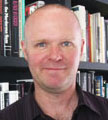The Dispassionate Industry by Adrian Danks |
 |
Over the last year or so I’ve spent a lot time
thinking about the small corpus of movies that deal with Australian film
history. This lack of volume, focus and even interest is part-and-parcel of an
often-amnesiac cinema that is inadequately attentive to local, national and
global film histories, as well as the lessons they have to offer. It also highlights
an unsurprising lack of traction for fiction narratives and documentaries that
dramatise the often less than dramatic patterns of production, distribution,
exhibition, financing and reception (let alone the vast untapped history of
what might be called “screen culture”) that have long defined and preoccupied
the thinking about cinema in Australia. Even the titles of two of the key works
on Australian film history before and after the “revival” (itself a convenient
narrative that fails to account for the diversity of what we should call Australian cinema) – David
Stratton’s The Last New Wave (1980) and
the documentary series The Celluloid
Heroes (Donald Crombie and Robert Francis, 1995) – suggest a degree of
desperation, drawing inexact reference, in the first instance, to the groundbreaking
global film movements of the 1950s and 1960s and in the second to the commonly
desperate narrative of brave souls (mostly heroically male, of course, and
seldom occupying any other role than director) scratching out some kind of heroic
career or oeuvre within a sparse terrain.
But when looking at these films more closely – from The Passionate Industry (Joan Long,
1973), The Picture Show Man (John
Power, 1977) and Newsfront (Phillip
Noyce, 1978) to Hunt Angels (Alec Morgan,
2006), Carlton + Godard = Cinema (Nigel
Buesst, 2003) and The Archive Project (John Hughes, 2006) – other patterns started to emerge. Many of the films made
since the turn of the century suggest a gratifying shift to a more dispersive,
grittier, playful and less nationally or
nationalistically focused vision of Australian cinema and its history, as well as
the role that a broader screen culture has to play within this. This is a view
that is supported by much of the scholarly work to emerge across the same
period, although it isn’t reflected in more popular histories like David Stratton: A Cinematic Life (Sally
Aitken, 2017) and Not Quite Hollywood (Mark Hartley, 2008). This emphasis draws a parallel with my own peripatetic
relationship to Australian cinema over the years, a set of experiences gleaned
across festival screenings, late-night TV showings and a slew of other often less
than salubrious screening opportunities. This perspective is supported by the
sobering reality of the global indifference that meets most Australian cinema –
we’re linked to the networks of international screen culture and completely on our own.
But this sense of dispersal also suggests the
possibilities for a more decentralised and diverse Australian cinema, one less
beholden to the whims and commercial imperatives of funding bodies, national
broadcasters and exhibitors. I’m all for publically funded or supported screen
production and culture, but this needs to favour diversity, aesthetics,
quality, access and history rather than focus on unlikely possibility of commercial
success. The true richness of Australian cinema incorporates a diverse range of
works across documentary, short form television, experimental cinema and then fiction feature filmmaking. As the
documentaries by Hughes, Buesst and others suggest, we need an idea of
“national” cinema that brings to mind a complex roll call of names (Joan Long,
Rupert Kathner, Brian Davies, Ivan Gaal, Michael Powell, Tracey Moffatt, Joris
Ivens, Catherine Duncan and the rest, including the multitude of
often-forgotten figures from broader screen culture) and organisations that
complicate and unsettle neat notions of origin. Do we even need the designation
“Australian” any longer? These “dispersive” films about Australian cinema
history recognise both the value of looking through a local lens and the total inadequacy
of doing so exclusively.
|
Published March 27, 2018. © Adrian Danks, March 2018
|